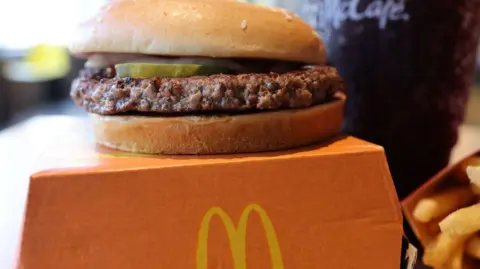
 Getty Images
Getty ImagesMcDonald’s has temporarily removed quarter pounders and fresh, slivered onions from the menu in about a fifth of its US stores due to an outbreak of deadly E. coli poisoning.
So far, the Centers for Disease Control and Prevention has recorded 49 cases of illness across 10 states. Ten cases resulted in patients being admitted to hospital and one person has died.
Most of the cases of E. coli, a type of bacteria that can cause serious stomach problems, were recorded in western and Midwest states, according to the CDC.
As health officials continue to investigate the source of the outbreak, other major food companies have also said they are withdrawing onions in the US.
Here’s what we know so far.
How large is the outbreak?
The 49 E. coli cases have largely been concentrated in the states of Colorado and Nebraska so far, the CDC said on Tuesday.
Of the 26 people sickened in Colorado, one older adult has died – which is the first death and only that has been connected to the outbreak.
The CDC said that an infected child is in hospital with a condition known as hemolytic uremic syndrome (HUS), which can cause kidney failure.
The first confirmed outbreak case was reported on 27 September, but McDonald’s said authorities only notified the company of their concerns late last week.
As of Wednesday, about a dozen of the people interviewed had identified eating a quarter pounder before contracting the illness.
The chain’s decision to remove the patties and onions from the menu affects stores in Colorado, Kansas, Utah, Wyoming, as well as parts of Idaho, Iowa, Missouri, Montana, Nebraska, Nevada, New Mexico, and Oklahoma.
Other hamburger items are not affected.
Burger King said on Thursday that about 5% of its restaurants receive onions from a supplier potentially linked to the outbreak. While there has been no indication of contamination or illness at those restaurants, the chain said they have disposed of the produce.
What is the source of the oubreak?
Investigators are eyeing the possibility that onions, a popular topping for McDonald’s quarter pounders, could be the cause of contamination.
The CDC and FDA said on Tuesday that they had not yet ruled out that the patties themselves could be to blame.
The chain has agreed with that assessment, though the company has said that its burgers are cooked to 175 degrees – which is above the 160 degree level needed to kill the E. coli bacteria
The cases involve purchases from multiple stores, making it unlikely that food preparation is to blame, McDonald’s said.
The company said the stores involved had used multiple suppliers for the beef patties, but shared a single supplier of onions – identified as California-based Taylor Farms, one of the world’s largest vegetable processors.
Taylor Farms, which works with major food suppliers such as US Foods, has issued its own recall of some batches of onions out of an abundance of caution.
Taylor Farms said in a statement provided to CBS News that it conducted tests on “raw and finished” onion products and “found no traces of E. coli”.
On Thursday, the fast food firm Yum! Brands said it was monitoring the outbreak and had decided to proactively remove fresh onions from “select Taco Bell, Pizza Hut and KFC restaurants” in the US.
The company declined to say how many locations were affected by the decision.
What is E. coli poisoning and what are the symptoms?
E. coli are a diverse group of bacteria that normally live in the intestines of humans and animals.
Although many are harmless, some produce toxins that can make humans very ill.
Symptoms include severe and sometimes bloody diarrhoea, stomach cramps, vomiting and fever.
Some infections can lead to other more serious problems, including kidney failure.
Symptoms tend to emerge three to nine days after eating the contaminated food.
What is the effect on McDonald’s?
McDonald’s shares opened down 7% on Wednesday, after news of the outbreak became public. They have since recovered some ground.
The burger giant said this week that it was too early to say how damaging it would be for sales.
It said that it believed it had removed the problem from its supply chain and is aiming to return quarter pounders to the affected states in the next few weeks.
But the issue came as McDonalds was already on the defensive, as customers have cut back on fast food spending.
The change in consumer spending has forced McDonalds and other chains to lean heavily on discounts and other promotions.





